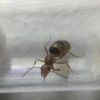Like a lot of people. I started off the hobby with fluon from ByFormica. The applicators seemed cool and easy to use. and I wanted the clarity. I never talk ill of stuff that I don't use (talc) but I always talked highly of fluon. I never understood how anyone would want that huge thick white border around their nests. Honestly, it could be user error but fluon has repetitively failed at containing my Crematogaster so I finally decided to use talc. Another reason I am switching over to talc is because I couldn't find fluon in a big bottle, especially now bioquip is closed. I wanted a bottle of it so I can use a brush to apply it. But yesterday, I applied talc to some outworlds so I can do a full transfer and back of the crema so I clean out their outworld. I can now confidently recommend talc. I didn't have the lid on and I felt okay with it. Definitely not something I could say about fluon. Talc makes it very easy to see which spots are missed. It was just an observation over a few hours and this morning. I will update this if they break out through talc too. My next option would be a moat. I used 91% alcohol from local target, talcum from amazon, and fan brush from amazon. A little goes a long way ( I had to dump 50% of the it). I think this talc bottle could last me forever.
Items:
Alcohol






















